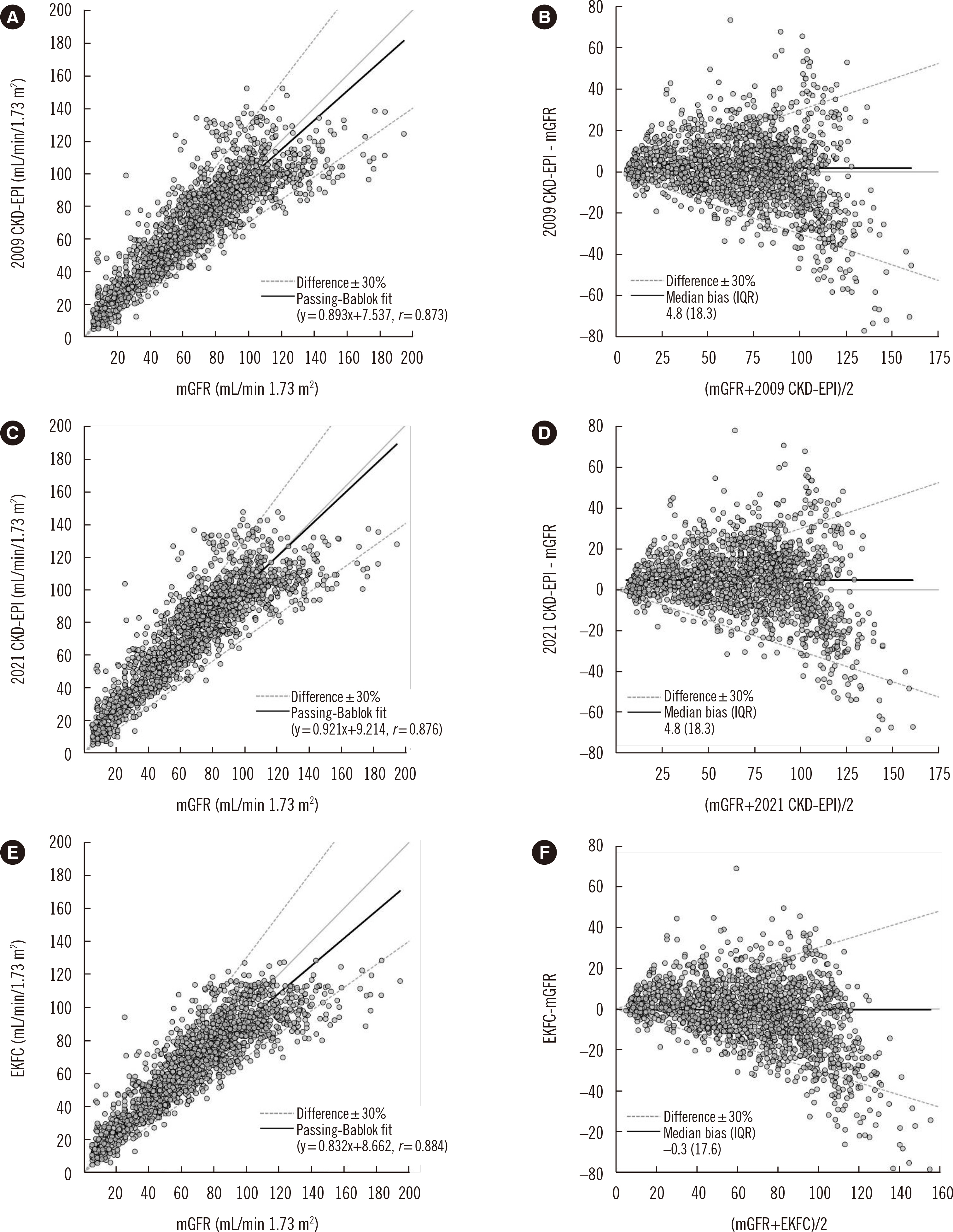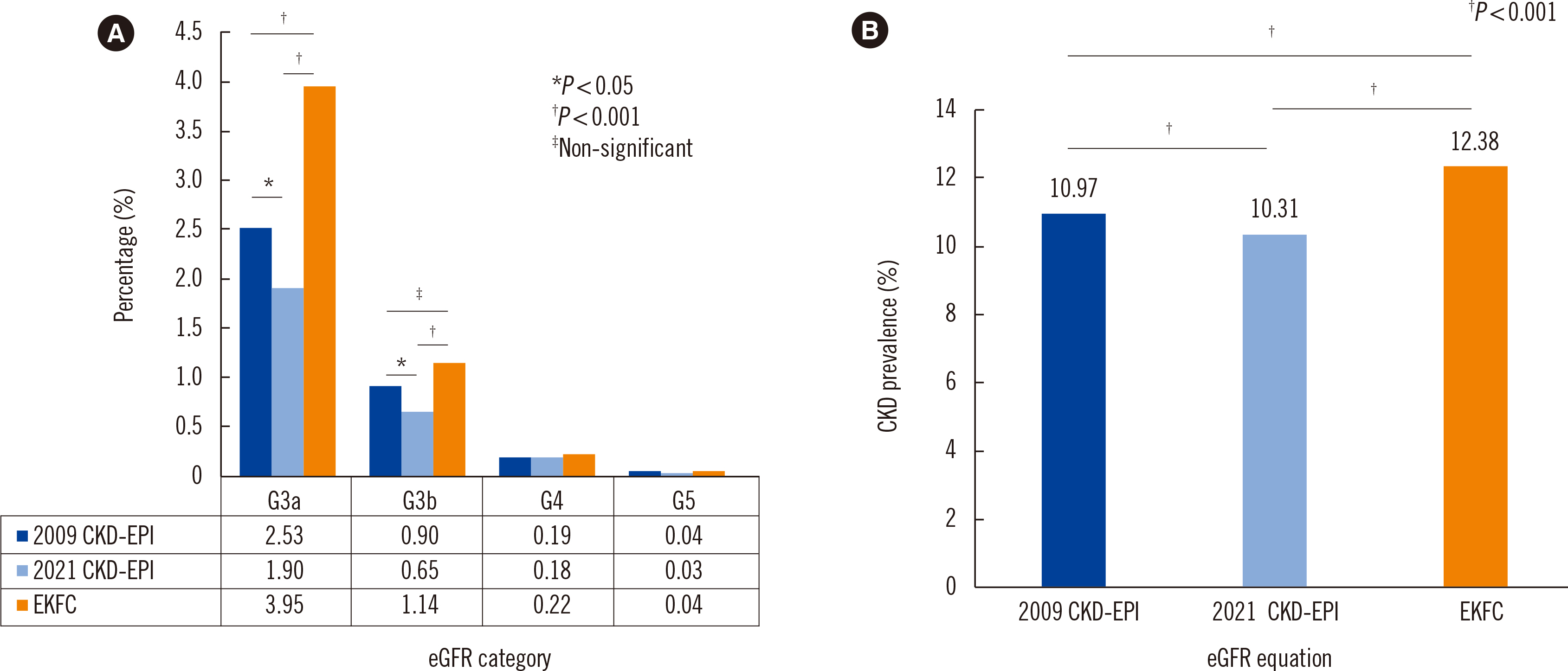Ann Lab Med.
2023 May;43(3):244-252. 10.3343/alm.2023.43.3.244.
Accuracy of the New Creatinine-based Equations for Estimating Glomerular Filtration Rate in Koreans
- Affiliations
-
- 1Department of Laboratory Medicine, Ewha Womans University College of Medicine, Seoul, Korea
- 2Department of Laboratory Medicine, Hallym University Chuncheon Sacred Heart Hospital, Chuncheon, Korea
- 3Department of Laboratory Medicine, University of Ulsan College of Medicine and Asan Medical Center, Seoul, Korea
- KMID: 2551708
- DOI: http://doi.org/10.3343/alm.2023.43.3.244
Abstract
- Background
New creatinine-based estimated glomerular filtration rate (eGFR) equations, including the 2021 Chronic Kidney Disease Epidemiology Collaboration (2021 CKD-EPI) and European Kidney Function Consortium (EKFC) equations, have been introduced recently. We assessed the performance of the 2021 CKD-EPI and EKFC equations in the Korean population.
Methods
We analyzed 1,654 Korean patients aged ≥18 years who underwent chromium-51-ethylenediamine tetraacetic acid GFR measurements (mGFR). Bias (eGFR–mGFR), root mean square error (RMSE), and proportion of eGFR within 30% of mGFR (P30) of the 2009 CKD-EPI, 2021 CKD-EPI, and EFKC equations were compared. The concordance rate between eGFR and mGFR categories was evaluated. Both eGFR and mGFR categories were classified into six groups: ≥90, 89–60, 59–45, 44–30, 29–15, and <15 mL/min/1.73 m2.
Results
The median bias (mL/min/1.73 m2) was 1.8 for the 2009 CKD-EPI equation, 4.8 for the 2021 CKD-EPI equation, and –0.3 for the EKFC equation. The P30 and RMSE were 78.2% and 17.0 for the 2009 CKD-EPI equation, 75.6% and 17.4 for the 2021 CKD-EPI equation, and 80.0% and 16.7 for the EKFC equation, respectively. The overall GFR category concordance rate between eGFR and mGFR was 63.4% for the 2009 CKD-EPI equation, 60.5% for the 2021 CKD-EPI equation, and 61.0% for the EKFC equation.
Conclusions
Among the three eGFR equations, the EKFC equation had the smallest bias and highest P30 in Koreans. The 2009 CKD-EPI equation had a lower bias than the 2021 CKD-EPI equation.
Figure
Cited by 3 articles
-
Skeletal Muscle Mass Measurement via Bioelectrical Impedance Analysis as an Aid to Screen for Chronic Kidney Disease in Routine Health Checkups
Seunghoo Lee, Sangpil Yoon, Sollip Kim, Woochang Lee, Sail Chun, Won-Ki Min
Ann Lab Med. 2024;44(1):100-102. doi: 10.3343/alm.2024.44.1.100.Exploring Renal Function Assessment: Creatinine, Cystatin C, and Estimated Glomerular Filtration Rate Focused on the European Kidney Function Consortium Equation
Hans Pottel, Pierre Delanaye, Etienne Cavalier
Ann Lab Med. 2024;44(2):135-143. doi: 10.3343/alm.2023.0237.Current Status of Standardization of Glomerular Filtration Rate Markers in Korea
Tae-Dong Jeong
Ann Lab Med. 2025;45(3):272-275. doi: 10.3343/alm.2024.0702.
Reference
-
1. Inker LA, Eneanya ND, Coresh J, Tighiouart H, Wang D, Sang Y, et al. 2021; New creatinine- and cystatin C-based equations to estimate GFR without race. N Engl J Med. 385:1737–49. DOI: 10.1056/NEJMoa2102953. PMID: 34554658. PMCID: PMC8822996.
Article2. Stevens LA, Coresh J, Greene T, Levey AS. 2006; Assessing kidney function-measured and estimated glomerular filtration rate. N Engl J Med. 354:2473–83. DOI: 10.1056/NEJMra054415. PMID: 16760447.
Article3. Levey AS, Coresh J, Tighiouart H, Greene T, Inker LA. 2019; Strengths and limitations of estimated and measured GFR. Nat Rev Nephrol. 15:784. DOI: 10.1038/s41581-019-0213-9. PMID: 31578495.
Article4. Nichols GA, Ustyugova A, Déruaz-Luyet A, O'Keeffe-Rosetti M, Brodovicz KG. 2020; Health care costs by type of expenditure across eGFR stages among patients with and without diabetes, cardiovascular disease, and heart failure. J Am Soc Nephrol. 31:1594–601. DOI: 10.1681/ASN.2019121308. PMID: 32487562. PMCID: PMC7350988.
Article5. GBD Chronic Kidney Disease Collaboration. Global, regional, and national burden of chronic kidney disease, 1990-2017: a systematic analysis for the Global Burden of Disease Study 2017. Lancet. 2020; 395:709–33.6. Miller WG, Jones GRD. 2018; Estimated glomerular filtration rate; laboratory implementation and current global status. Adv Chronic Kidney Dis. 25:7–13. DOI: 10.1053/j.ackd.2017.09.013. PMID: 29499890.
Article7. Miller WG, Kaufman HW, Levey AS, Straseski JA, Wilhelms KW, Yu HE, et al. 2022; National Kidney Foundation Laboratory Engagement Working Group recommendations for implementing the CKD-EPI 2021 race-free equations for estimated glomerular filtration rate: practical guidance for clinical laboratories. Clin Chem. 68:511–20. DOI: 10.1093/clinchem/hvab278. PMID: 34918062.
Article8. Kim SK, Jeong TD, Park S, Lee YW, Min WK. 2019; Current status of estimated glomerular filtration rate reporting in Korea. J Lab Med Qual Assur. 41:201–6. DOI: 10.15263/jlmqa.2019.41.4.201.
Article9. Costa NR, Carvalho ARM, Pinto CMA, Andriolo A, Guerra IC. 2017; Laboratory diagnosis of chronic kidney disease in adults: an overview of hospitals inserted in the Portuguese National Health System. J Bras Patol Med Lab. 53:388–96. DOI: 10.5935/1676-2444.20170062.10. Madero M, Sarnak MJ. 2011; Creatinine-based formulae for estimating glomerular filtration rate: is it time to change to chronic kidney disease epidemiology collaboration equation? Curr Opin Nephrol Hypertens. 20:622–30. DOI: 10.1097/MNH.0b013e32834ba210. PMID: 21941179.11. Levey AS, Bosch JP, Lewis JB, Greene T, Rogers N, Roth D. 1999; A more accurate method to estimate glomerular filtration rate from serum creatinine: a new prediction equation. Modification of Diet in Renal Disease Study Group. Ann Intern Med. 130:461–70. DOI: 10.7326/0003-4819-130-6-199903160-00002. PMID: 10075613.
Article12. Levey AS, Stevens LA, Schmid CH, Zhang YL, Castro AF, Feldman HI, et al. 2009; A new equation to estimate glomerular filtration rate. Ann Intern Med. 150:604–12. DOI: 10.7326/0003-4819-150-9-200905050-00006. PMID: 19414839. PMCID: PMC2763564.
Article13. Delgado C, Baweja M, Burrows NR, Crews DC, Eneanya ND, Gadegbeku CA, et al. 2021; Reassessing the inclusion of race in diagnosing kidney diseases: an interim report from the NKF-ASN task force. J Am Soc Nephrol. 32:1305–17. DOI: 10.1681/ASN.2021010039. PMID: 33837122. PMCID: PMC8259639.
Article14. Cerdeña JP, Plaisime MV, Tsai J. 2020; From race-based to race-conscious medicine: how anti-racist uprisings call us to act. Lancet. 396:1125–8. DOI: 10.1016/S0140-6736(20)32076-6. PMID: 33038972.
Article15. Vyas DA, Eisenstein LG, Jones DS. 2020; Hidden in plain sight-reconsidering the use of race correction in clinical algorithms. N Engl J Med. 383:874–82. DOI: 10.1056/NEJMms2004740. PMID: 32853499.
Article16. Oni-Orisan A, Mavura Y, Banda Y, Thornton TA, Sebro R. 2021; Embracing genetic diversity to improve black health. N Engl J Med. 384:1163–7. DOI: 10.1056/NEJMms2031080. PMID: 33567186.
Article17. Ioannidis JPA, Powe NR, Yancy C. 2021; Recalibrating the use of race in medical research. JAMA. 325:623–4. DOI: 10.1001/jama.2021.0003. PMID: 33492329.
Article18. Pottel H, Björk Bjork J, Courbebaisse M, Couzi L, Ebert N, Eriksen BO, et al. 2021; Development and validation of a modified full age spectrum creatinine-based equation to estimate glomerular filtration rate: a cross-sectional analysis of pooled data. Ann Intern Med. 174:183–91. DOI: 10.7326/M20-4366. PMID: 33166224.
Article19. Pottel H, Hoste L, Dubourg L, Ebert N, Schaeffner E, Eriksen BO, et al. 2016; An estimated glomerular filtration rate equation for the full age spectrum. Nephrol Dial Transplant. 31:798–806. DOI: 10.1093/ndt/gfv454. PMID: 26932693. PMCID: PMC4848755.
Article20. KDIGO 2012 clinical practice guideline for the evaluation and management of chronic kidney disease. Kidney Int. 2013; 3:19–62.21. Meeusen JW, Kasozi RN, Larson TS, Lieske JC. 2022; Clinical impact of the refit CKD-EPI 2021 creatinine-based eGFR equation. Clin Chem. 68:534–9. DOI: 10.1093/clinchem/hvab282. PMID: 35038721.
Article22. Levey AS, Tighiouart H, Inker LA. 2021; Improving glomerular filtration rate estimation-across the age and diversity spectrum. Ann Intern Med. 174:265–7. DOI: 10.7326/M20-6983. PMID: 33166223.
Article23. Fleming JS, Zivanovic MA, Blake GM, Burniston M, Cosgriff PS. British Nuclear Medicine Society. 2004; Guidelines for the measurement of glomerular filtration rate using plasma sampling. Nucl Med Commun. 25:759–69. DOI: 10.1097/01.mnm.0000136715.71820.4a. PMID: 15266169.
Article24. Campbell MJ, Gardner MJ. 1988; Calculating confidence intervals for some non-parametric analyses. Br Med J (Clin Res Ed). 296:1454–6. DOI: 10.1136/bmj.296.6634.1454. PMID: 3132290. PMCID: PMC2545906.25. National Kidney Foundation. K/DOQI clinical practice guidelines for chronic kidney disease: evaluation, classification, and stratification. Am J Kidney Dis. 2002; 39(2 Suppl 1):S1–266.26. Marzinke MA, Greene DN, Bossuyt PM, Chambliss AB, Cirrincione LR, McCudden CR, et al. 2022; Limited evidence for use of a black race modifier in eGFR calculations: a systematic review. Clin Chem. 68:521–33. DOI: 10.1093/clinchem/hvab279. PMID: 34927677.
Article27. Delgado C, Baweja M, Crews DC, Eneanya ND, Gadegbeku CA, Inker LA, et al. 2022; A unifying approach for GFR estimation: recommendations of the NKF-ASN task force on reassessing the inclusion of race in diagnosing kidney disease. Am J Kidney Dis. 79:268–88.e1. DOI: 10.1053/j.ajkd.2021.08.003. PMID: 34563581.
Article28. Jeong TD, Cho EJ, Lee K, Lee W, Yun YM, Chun S, et al. 2021; Recent trends in creatinine assays in Korea: long-term accuracy-based proficiency testing survey data by the Korean Association of External Quality Assessment Service (2011-2019). Ann Lab Med. 41:372–9. DOI: 10.3343/alm.2021.41.4.372. PMID: 33536355. PMCID: PMC7884186.
Article29. Arora P, Rajagopalan S, Patel N, Nainani N, Venuto RC, Lohr JW. 2012; The MDRD equation underestimates the prevalence of CKD among blacks and overestimates the prevalence of CKD among whites compared to the CKD-EPI equation: a retrospective cohort study. BMC Nephrol. 13:4. DOI: 10.1186/1471-2369-13-4. PMID: 22264268. PMCID: PMC3398292.
Article30. Delanaye P, Cavalier E, Mariat C, Maillard N, Krzesinski JM. 2010; MDRD or CKD-EPI study equations for estimating prevalence of stage 3 CKD in epidemiological studies: which difference? Is this difference relevant? BMC Nephrol. 11:8. DOI: 10.1186/1471-2369-11-8. PMID: 20515483. PMCID: PMC2891733.
Article
- Full Text Links
- Actions
-
Cited
- CITED
-
- Close
- Share
- Similar articles
-
- Accuracy Assessment of Five Equations Used for Estimating the Glomerular Filtration Rate in Korean Adults
- The Value of Serum Concentration of Cystatin C as a Marker for Glomerular Filtration Rate in Children and Adolescents
- Estimated Glomerular Filtration Rates Show Minor but Significant Differences Between the Single and Subgroup Creatinine-Based Chronic Kidney Disease Epidemiology Collaboration Equations
- Estimation of Glomerular Filtration Rate from Plasma Creatinine and Height in Premature and Fullterm Neonates
- Interpretation of Estimated Glomerular Filtration Rate



